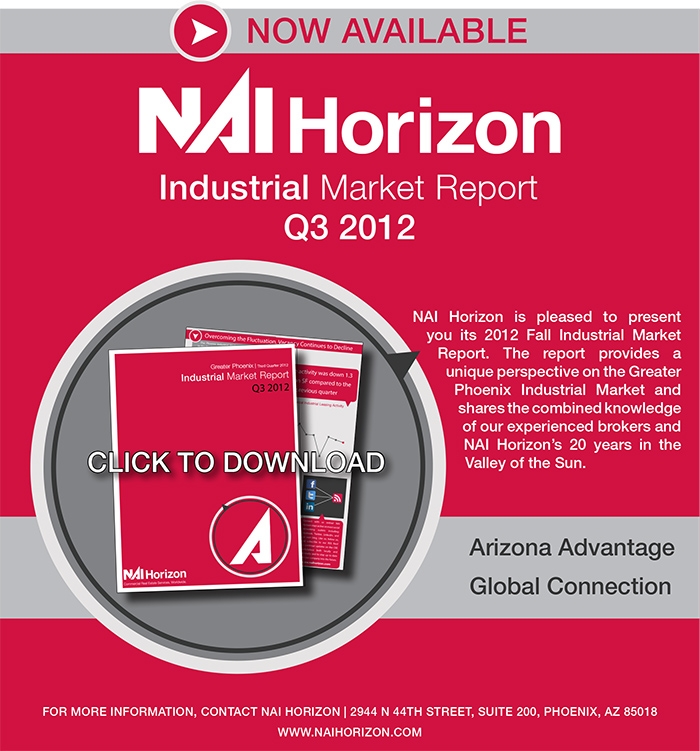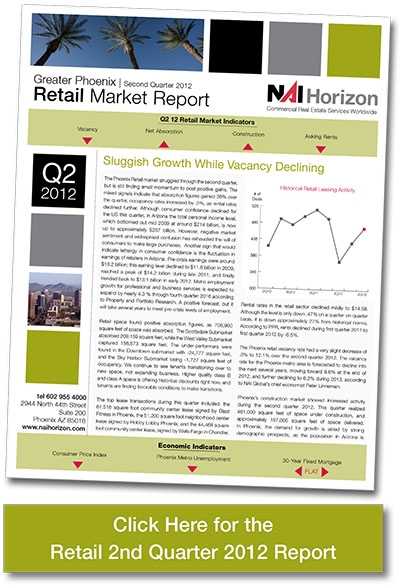The Phoenix Industrial Market noticed moderate changes in the third quarter of 2012. There was a significant decrease in the square footage of absorbed space, still vacancy rates are heading in the right direction. With exports and manufacturing expanding throughout the US, there should be a continued increase in industrial space demand. In addition to this growth, there was a significant jump in new industrial construction starts this quarter. Construction and manufacturing jobs remained flat; the dismal level must make large strides to recover the more than 200,000 jobs lost during the crash.
644,000 SF of space was absorbed this quarter, down dramatically from the approximately 2.6 million square feet of space absorbed during the second quarter of 2012. Even though absorption decreased this quarter, it marks the tenth straight quarter of positive absorption. This decrease can be attributed to expected fluctuations as we pull out of the financial crisis. The largest increase in absorption was observed in the Northwest Valley submarket, which includes Glendale and Deer Valley, increasing by 24% to nearly 390,000 SF. Distribution related facilities noticed the largest declines; third quarter absorption for distribution industrial sites decreased from 915,100 SF to (221,787) SF. While the Southwest Valley lost traction this quarter recording (191,368) SF of absorbed space, the Southeast Valley showed improvement with a gain of approximately 450,000 SF.
In contrast to the decrease in absorbed space, vacancy rates showed signs of improvement. The vacancy rate for the third quarter inched down to 13.2% from 13.4% the previous quarter. Only distribution facilities showed an increase in vacancy rates, moving up 0.2% to 9.2% at the end of the third quarter. Across all submarkets, the vacancy rates maintained consistent levels. The lowest rate was noticed in the Northwest Valley submarket, with a 12.0% rate. Compared to the previous quarter, vacancy for manufacturing space declined .3% to 10.8%. This increased demand is likely affected by spending growth in the tech and defense sectors.
Lease transactions noticed a brief decline in square footage; activity was down 1.3 million SF compared to the previous quarter. On a year over year basis, the percent of occupancy increased from 86.9% to 88.2%. The two largest leasing transactions this quarter were both in the Tolleson market. A 276,336 SF lease at 10397 W Van Buren St signed by State Logistics Services, and a 238,450 SF lease signed by Communications Test Design Inc at 8602 W Buckeye Rd.
Rental rates in the Valley found minor increases, inching up to $.51 per SF ($6.17 annually), a 1.6% increase for the quarter. Landlords are hesitant to increase rates as the fiscal situation nationwide warrants risk adverse decisions from tenants looking to relocate.
There was no new space delivered in the third quarter but construction starts showed an increase. Projects undergoing construction increased this quarter to approximately 3.8 million SF, an increase of nearly 500,000 SF. The largest projects initiated were the First Solar Factory, a 1,200,000 SF building with 0% of its space pre-leased. Also started this quarter was FAB 42, an Intel Corp building with 1,000,000 SF that is 100% pre-leased.
Cap rates continued their descent, as rates trended down to 6.26%, from a previous 6.93%. That is significant improvement as the previous quarter saw rates drop 2%. The lower cap rates play to the theme of the quarter, positive but slight momentum. Across the nation, the results were mimicked, as cap rates trended down to 7.5% from 7.67% during the second quarter. There was a continuance of large scale industrial assets purchase. One such example was the 20-property industrial portfolio acquisition by Brennan Investment Group and Gatehouse Bank, acquired from AIC Ventures for $155 million. Increases in manufacturing activity and the continued expansion of our defense needs poise the industrial sector for heightened demand.


